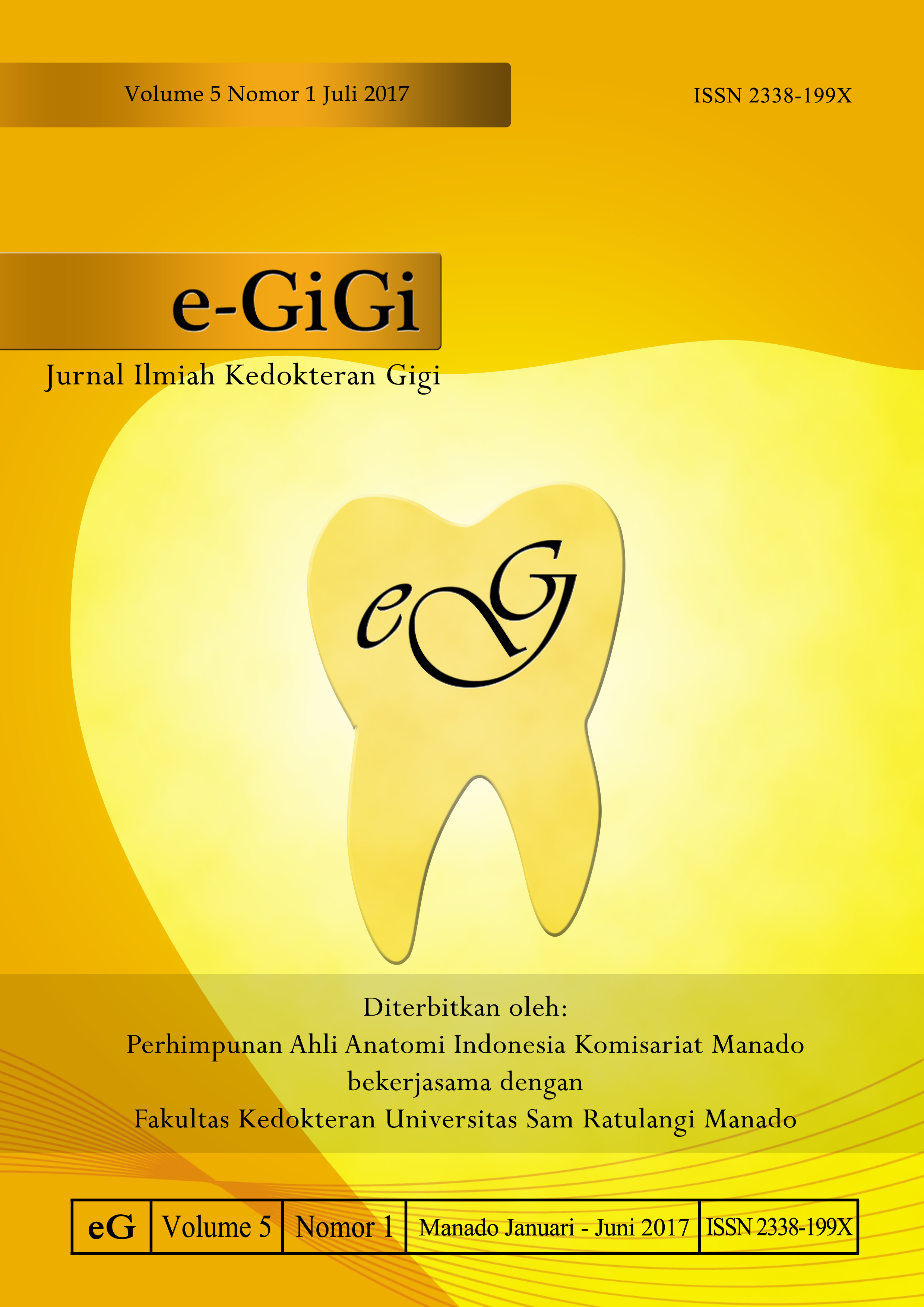Pengaruh perendaman plat resin akrilik dalam larutan kopi dengan berbagai kekentalan terhadap perubahan volume larutan kopi
DOI:
https://doi.org/10.35790/eg.5.1.2017.14738Abstract
Abstract: Acrylic resin is a denture base material that is still used in the field of dentistry. Porosity, one of the properties of a denture base material, can lead to absorption of fluid in the mouth, one of them is coffee. Porosity that occurs in a denture base material can cause discoloration. Coffee is favored by most people. Coffee contains tannins, a polyphenol compound, that can be absorbed through the porous of the denture base which can cause discoloration of the denture base. This study was aimed to determine the effect of acrylic resin plate immersed in coffee solution with various viscosity to the changes in volume of coffee solution. This was a pre laboratory experimental study with a pre and post test only control group design. Samples were 18 acrylic resin plates with a size of 65 x 10 x 2.5 mm. Each treatment group consisted of 6 samples. The samples were divided into 3 treatment groups that were soaked in coffee 2 g, 4 g, and 6 g for 7 days. The results showed that after 7 days of immersing resin acrylic plates in coffee solution with various viscosity, the changes of the volumes of coffee solution had a mean of 0.064 for 2 g; 0.147 for 4 g; and 0.244 for 6 g. The one-way ANOVA test resulted in a p value of 0.00. Conclusion: There was a significant effect of resin acrylic immersed in a coffee solution with various viscosity to the changes in the volume of coffee solution.
Keywords: acrylic resin, changes in volume of the solution of coffee, coffee
Â
Abstrak: Resin akrilik merupakan bahan basis gigi tiruan yang sampai saat ini masih digunakan dalam bidang Kedokteran Gigi. Porositas merupakan salah satu sifat basis gigi tiruan. Adanya porositas pada basis gigi tiruan dapat mengakibatkan terserapnya cairan yang masuk dalam mulut salah satunya yaitu kopi. Porositas yang terjadi pada basis gigi tiruan dapat menyebabkan perubahan warna pada basis gigi tiruan. Kopi merupakan salah satu minuman yang banyak digemari masyarakat. Kopi mengandung tanin suatu senyawa polifenol yang dapat terserap masuk melalui porus pada basis gigi tiruan dan menyebabkan perubahan warna pada basis gigi tiruan. Penelitian ini bertujuan untuk mengetahui pengaruh perendaman plat resin akrilik dalam larutan kopi dengan berbagai kekentalan terhadap perubahan volume larutan kopi. Jenis penelitian ialah pra eksperimental laboratorium dengan pre and post test only control group design. Sampel terdiri dari 18 plat resin akrilik dengan ukuran 65 x 10 x 2,5 mm. Sampel dibagi menjadi 3 kelompok perlakuan yang di rendam dalam kopi 2gr, 4gr, dan 6gr selama 7 hari. Masing-masing kelompok perlakuan terdiri dari 6 sampel. Hasil penelitian mendapatkan setelah 7 hari perendaman plat akrilik dalam larutan kopi dengan berbagai kekentalan terhadap perubahan volume larutan kopi memiliki rerata kopi 2 gr sebesar 0,064, kopi 4 gr sebesar 0,147. dan kopi 6 gr sebesar 0,244. Uji One-way Anova menunjukkan adanya pengaruh perendaman resin akrilik dalam larutan kopi dengan berbagai kekentalan terhadap perubahan volume larutan kopi dengan p=0,00. Simpulan: Terdapat pengaruh bermakna dari perendaman resin akrilik dalam larutan kopi dengan berbagai kekentalan terhadap perubahan volume larutan kopi
Kata kunci: resin akrilik, perubahan volume larutan kopi, kopi
Downloads
How to Cite
Issue
Section
License
COPYRIGHT
Authors who publish with this journal agree to the following terms:
Authors hold their copyright and grant this journal the privilege of first publication, with the work simultaneously licensed under a Creative Commons Attribution License that permits others to impart the work with an acknowledgment of the work's origin and initial publication by this journal.
Authors can enter into separate or additional contractual arrangements for the non-exclusive distribution of the journal's published version of the work (for example, post it to an institutional repository or publish it in a book), with an acknowledgment of its underlying publication in this journal.
Authors are permitted and encouraged to post their work online (for example, in institutional repositories or on their website) as it can lead to productive exchanges, as well as earlier and greater citation of the published work (See The Effect of Open Access).






